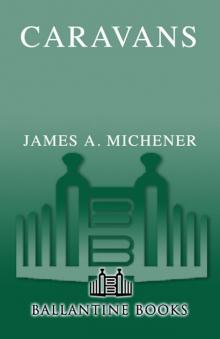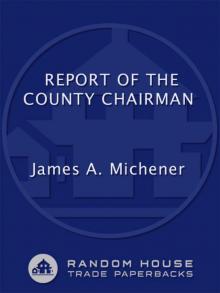- Home
- James A. Michener
This Noble Land: My Vision for America Page 3
This Noble Land: My Vision for America Read online
Page 3
Several observations should be quickly made. The conspicuous fortunes like the Rockefellers’, the Fords’, the Carnegies’ and the Dewitt Wallaces’ have been converted into great trusts whose yearly interest on their investments is applied to the public good. The money has not been wasted, and many other families in this elite group have established their own foundations with equally commendable purposes but with smaller initial funding. Unfortunately, other possessors of large fortunes have been social parasites, contributing little but their income taxes, while still others—the bill Gateses and the Paul Allens, for example—have so recently emerged that we cannot guess what directions they will take when their period of accumulation has ended.
From time to time I shall consider historical precedents that throw light upon our situation, and few of these will be more illustrative than an overview of what happened in several earlier societies when the ownership of wealth became dangerously un-balanced. One such period, when stupendous fortunes were concentrated in a few hands, occurred in the medieval era when all Europe and some of northern Africa was unified in one dominant religion. The Catholic Church proliferated with its Roman and Orthodox branches and was extremely wealthy. To increase its riches the Church’s officials paid special attention to older men and women of wealth, especially well-to-do widows. As these Christians approached death the Church applied heavy pressure on them to will to the Church their money, their art holdings and especially the vast lands they had acquired.
Many of these wealthy old patrons succumbed to the Church’s blandishments and willed all their holdings to the nearby monasteries or convents, so that over time the religious orders became the custodians of a large percentage of the society’s wealth. This transfer of money, art and material wealth other than land did little damage to the general economy, but it did create envy and animosity among the kings, nobles and lesser rulers, who saw that what might otherwise have come to them had instead been acquired by the Church.
Real harm to the general welfare of the countryside did occur, however, with the transfer of land to the Church because it withdrew huge tracts from the peasants who had fed their families from crops grown on land they had for generations considered their own. Even though they had not owned the land, they felt themselves entitled to continued occupancy. Once the lands came under the control of the Church, however, the peasants learned they would no longer be allowed to control any of the produce of the lands they tilled. All produce entered the marketplace under the ownership of the Church, which grew richer while the poor grew poorer.
This appallingly negative process became known as Le Mortmain de l’Église, the dead hand of the Church. By retaining both the land and all of its produce for its own profit, the Church disrupted the traditional customs of merchandising. It converted the once semifree peasants into serfs, who now had to buy the produce they themselves had raised. Some trivial economic benefit did result from this transfer of land to the Church, for monks proved to be able custodians, but the benefits were far less than what a diligent peasantry controlling the produce from its own fields or from the fields of its masters could have produced.
In the fourteenth and fifteenth centuries this dead hand of the Church became so oppressive that rumors of rebellion began to circulate, and in the opening years of the sixteenth century dramatic events unfolded in various parts of Europe that would modify the history of the world. In England, King Henry VIII began his stormy involvement with a succession of six wives by divorcing his first, Catherine of Aragon, and beheading two of her successors. To win his divorce Henry had to defy both the religious strictures against divorce and the dictates that the pope thundered at him from Rome. In surprisingly quick order Henry showed himself strong enough to ignore the pope and to lead the Catholic Church in England into open rebellion against papal authority. While remaining outwardly Catholic, the English Church sowed the seed that would end in its becoming a Church of its own, the established Church of England.
Having accomplished what at the time must have seemed a miracle, for the Catholic Church of Rome was all-powerful, Henry broadened his campaign against the pope by ordering that all the monasteries and convents in England be dissolved, the monks and nuns thrown out into the countryside, and the ownership of Church lands transferred to local knights and barons to ensure their loyalty to the Crown. The dead hand of the Church was thus transformed into the bold hand of the barons. The lot of the peasants attached to the land was not conspicuously improved; nor were the agricultural practices. But a vast revolutionary change had swept England: a new Church, a new landownership, a new spirit of defiance. A cynic has accurately summarized the peaceful revolution: ‘So Protestantism in England was born of concupiscence and cupidity.’
There is no evidence that Henry engineered his break from Rome with any avowed intention of transferring Church property to the barons, but that is what happened. Nor did he intend to convert the serfs of the Church into semifreemen responsible to local English landlords, but that also happened. It was a revolution of enormous significance, which started with a divorce proceeding and ended in a fundamental change in landownership.
Meanwhile, in Germany, a stubborn monk, Martin Luther, was launching his own rebellion against papal authority. Initially, his was a clean-cut philosophical rebellion, which, from the start, presaged an eventual break with Rome and the establishment of a new denomination, Lutheranism, although he never called it that. (Toward the close of his rebellion, sex played a role much as it had with Henry VIII; Luther enticed the nun Katharina von Bora to leave her convent by renouncing her vows and to marry him.)
Luther’s plans initially contained nothing parallel to the dissolution of the English monasteries; indeed, when revolutionary German peasants tried to wrest lands from the Church, Luther sided with the Church and against the peasants. He wanted no physical uprisings in Germany, merely the ecclesiastical reordering of Church procedures and freedom from the domination of the monks, who had been so oppressive and in many instances totally inept.
Eventually, following the revolutions in theology begun by Luther, movements did occur to divest the monasteries of their vast landholdings, and the results were similar to those in England: the newly freed lands fell into the hands of the nobility while the serfs profited little.
Within a relatively few decades, these two rebellious denominations reshaped the history of modern Europe: an independent Church of England only slightly removed, in ritual, from Rome; and lusty Lutheranism, whose principles would become manifest in various nations, each under its own charismatic leadership: Ulrich Zwingli in Switzerland, John Knox in Scotland, and especially John Calvin in scattered localities throughout Europe.
In the parts of continental Europe where the Protestant revolutions did not take hold, neither did the revolution in landownership occur, and vast landholdings remained concentrated either in the monasteries or with seminoble patrons. These lands were called latifundia in Spain, in eastern Europe and, in time, in the New World countries. I was on the scene in several countries when some of the latifundia were broken up and tillable lands distributed to the peasants—it occurred in Mexico when I worked there—but even today in some nations in Latin America, such as Argentina, and in certain parts of eastern Europe the great estates remain undivided.
Why is the situation of medieval Europe applicable to our situation today in the United States? Certainly vast Church holdings never became an aspect of our land management. Indeed, in 1862 during our Civil War, our Congress passed three extraordinary acts that literally gave away to private farmers and others the latifundia that our nation had accumulated. The Homestead Act gave worthy settlers free farmland; the Morrill Act set aside huge tracts of good land to finance agricultural colleges that charged minimal or even no student fees; and, in the same years, Congress quietly gave to the railways that had been inching their way westward enormous grants of free land to be used by them to encourage settlement in the West. I judge these three laws to
have been among the wisest ever passed by our Congress, and I believe they helped us to avoid the radical solutions to landownership that so frequently tore Europe apart.
But did we completely escape problems similar to those created by Le Mortmain de l’Église? Not at all. Our indecent concentrations of power have occurred not in landownership but in the ownership of other forms of our nation’s tangible wealth. In the 1520s England and Germany faced revolution of one kind or another; now, nearly five hundred years later, the United States is heading down the path toward its own version of revolution.
As American wealth has been accumulating in fewer pockets, the salaried workers of the huge middle class have watched their incomes remain static or even decline. The bottom third of society has slid ever closer to the poverty level, while those already in poverty have found no way to work themselves out of it. In the 1980s legal government policies were established with but one apparent objective: to enable the rich to grow even richer while the poor were pushed to ever-lower rungs on the economic ladder. The 1980s were a decade of shame.
The figures of inherited and accumulated wealth that I listed at the beginning of this chapter are interesting and indicative of a major problem in our society, but even more meaningful to the average observer are the grotesque amounts of yearly income being acquired today by many of our nation’s new millionaires. A small sampling of these includes:
Contemporary Yearly Income, Including in Some Cases Bonuses and Stock Options
Contrast the above incomes with:
There is a vast psychological difference between the first table, which shows accumulated wealth and inherited fortunes, and this small sampling of contemporary yearly incomes. Many of the names in the first list are those of historic figures who accumulated their fortunes in the distant past. The modern citizen does not envy them their good fortune; it happened so long ago and there is nothing we can do about it.
But the names in the second list are our contemporaries. Many could be the man or woman next door, some of them relatively young, and their excessive incomes become a matter of moment. Although we can see lasting proof of the socially desirable ways in which many of the past inheritors of great wealth converted their money into commendable foundations, we have little proof as to how these newly rich will distribute theirs. We catch fleeting glimpses of this or that celebrity’s making a gift to a school or to a movement that has social merit, but even these relative pittances are offset by the appalling illustrations of opulent decadence, such as the dream house young Bill Gates is building in the Seattle area for himself and his bride. With forty thousand square feet of living space at a cost of some $30 million, it goes far beyond Thorstein Veblen’s notion of conspicuous consumption.
But if thoughtful Americans do not waste time envying the recipients of great wealth, they are obligated to consider the evils that ensue when a nation’s wealth is distributed with cruel unfairness. In late June 1996 a study group at the University of Michigan, which has been conducting an ongoing analysis of how the wealth of America is distributed, released data proving conclusively that the rich families in America were indeed getting richer by the hour, while the people at the bottom of the economic ladder remained in dire poverty. More specifically, as reported by The New York Times, the Michigan data found that ‘The most prosperous 10 percent of American households held 61.1 percent of the nation’s wealth in 1989 and 66.8 percent in late 1994.’ Just two days before the Michigan figures were announced, the Census Bureau released its own study of the same phenomena, confirming that there is an ever-widening disparity between the rich and other segments of society.
My own prediction based on the Michigan data is that year by year the discrepancy between rich and poor will grow wider until finally it will become intolerable. If my extrapolations are correct, I would expect that some time in the next century something will snap and there will be a violent upheaval. The grossly unequal distribution of wealth is felt most brutally in the family incomes of the very poor. The government’s 1993 definition of the poverty level for a family of three is a family income of less than $11,522 a year; in the United States in that year 15.1 percent of the nation’s population fell below the official government poverty level. Only government intervention in the form of food stamps, rental allowances and aid for the children of deprived families enabled these very poor to continue to function even at a very low level.
The plight of our poor today is similar to what the dispossessed suffered in medieval Europe or what they experienced in Dickensian Britain a century and a half ago. We have made some progress in caring for our poor, but not nearly what a great industrial nation should have achieved.
Forbes magazine, in its issue of November 21, 1994, revealed a nasty secret about how some of the very rich handle their wealth. The magazine listed six American multibillionaires by name and business affiliation who had discovered a clever trick for avoiding taxes on the yearly income from their investments. A billion dollars prudently invested can yield many millions of income every year without invading the principal. According to Forbes, these six billionaires, who were named and photographed by Forbes, simply left the United States, legally renouncing their American citizenship, and enjoyed millions of dollars of tax-free income. The story was also picked up by The New York Times and The Wall Street Journal.
Most conspicuous among the expatriates identified by Forbes was young John T. Dorrance III, scion of the Campbell Soup Company, who resides in Ireland. The Campbell heir’s fortune is similar to that of the Ford family’s in that both fortunes were acquired by providing the nation with a much-sought-after commodity—in Ford’s case a reasonably priced automobile, in Campbell’s a good canned soup that quickly established itself as a best buy in the marketplace. But there the similarity ends because Ford’s family used much of its fortune to endow a major foundation that has sponsored many worthwhile charities and studies of American life, whereas, although Campbell Soup also has a foundation, a Campbell heir has opted, according to Forbes, to leave the country that sustained him to take advantage of tax alternatives available out of the country. (A Campbell spokesperson didn’t have an official confirmation of Mr. Dorrance’s citizenship, but did say in June 1996 that Mr. Dorrance’s ‘official residence is outside the United States, in Ireland.’)
Self-expatriation to avoid U.S. taxes on fortunes earned in the United States widens the gap between rich and poor, and sends a dangerous message to the less affluent, who often feel heavily burdened by the taxes they conscientiously pay. Such an action is so offensive that I find it difficult to express the full extent of my condemnation.
Once the tax-avoidance loophole became apparent, our government proposed a new tax that would eliminate the advantages enjoyed by the expatriates, but powerful lobbyists rushed in to protect the billionaires. They claimed that the proposed tax might disrupt ordinary trade relations between nations, it might discourage foreign persons from investing in American businesses, it might involve double taxation, and so on. But the underlying thread of all this was the assumption that it would be unfair to the billionaires who had worked hard to amass their wealth. Action on the proposed new law was delayed; a year later, a couple of versions are still pending, and the largess to the already rich continues. No comparable concessions have been made to the middle or lower classes.
Everyone has an opinion about taxes, and mine is based on long and bewildering experience. When I filed my last yearly report the paperwork required forty-eight pages of computations—I had a modest income from numerous foreign countries, all with different rules—and of this blizzard of figures I could understand only about the first three pages. It is preposterous that a national tax program should be so complicated that even an individual with an advanced college degree has no chance whatever of filing his own tax return and therefore has to hire an accountant.
I have often daydreamed about an easier system in which I could list at the end of the year every penny I’d earned and th
en pay a clearly defined and understandable tax—no deductions, no tax-evasion gambits, no chicanery, no accountants. I supposed that would never happen, because it was too sensible, too easy, and allowed no room for Congress to tuck into tax law little goodies for their constituents. But now I find that leaders in Congress are seriously considering what has been termed a flat tax, which is almost the same as what I had dreamed of. Proponents make intelligent defenses of such a tax, and others refine it a bit by introducing three or four levels of taxation, each level of income being taxed more than the level below. Thus the poor might pay nothing, the next level a minimum, and each step upward a little more. The top level would not be confiscatory. I decided that I preferred the simple flat tax, no gradations.
But as soon as I elected that system, financial counselors put forth a score of reasons why it either would not work or would be unfair to many levels if it did work. I was left bewildered, but either version of a flat or near-flat tax would be preferable to what I live with today.
However, the flat tax does nothing to alleviate the differences between rich and poor; indeed, the versions I’ve heard about leave the poor where they were but award the already rich with substantial benefits and, in many cases, lower taxes. Unless the proposed systems rectify this imbalance I would not be able to support them.
Looking carefully at the distress of the very poor and the severe financial discomfort of many in the middle class, I regretfully conclude that these imbalances in income will continue in American life indefinitely. But we shall have to alleviate the problem one way or another.

 Mexico
Mexico The World Is My Home: A Memoir
The World Is My Home: A Memoir Sayonara
Sayonara Chesapeake
Chesapeake The Novel
The Novel Rascals in Paradise
Rascals in Paradise Return to Paradise
Return to Paradise Presidential Lottery: The Reckless Gamble in Our Electoral System
Presidential Lottery: The Reckless Gamble in Our Electoral System The Source
The Source Poland
Poland Space
Space Caravans
Caravans Creatures of the Kingdom: Stories of Animals and Nature
Creatures of the Kingdom: Stories of Animals and Nature Iberia
Iberia Hawaii
Hawaii The Watermen: Selections From Chesapeake
The Watermen: Selections From Chesapeake Report of the County Chairman
Report of the County Chairman The Covenant
The Covenant The Bridges at Toko-ri
The Bridges at Toko-ri Matecumbe
Matecumbe Journey: A Novel
Journey: A Novel Centennial
Centennial Sports in America
Sports in America Texas
Texas Miracle in Seville
Miracle in Seville This Noble Land: My Vision for America
This Noble Land: My Vision for America Tales of the South Pacific
Tales of the South Pacific Bridges at Toko-Ri
Bridges at Toko-Ri Space: A Novel
Space: A Novel Presidential Lottery
Presidential Lottery Sayonara: A Novel
Sayonara: A Novel This Noble Land
This Noble Land The Covenant: A Novel
The Covenant: A Novel Miracle in Seville: A Novel
Miracle in Seville: A Novel The Bridge at Andau
The Bridge at Andau Source
Source The Source: A Novel
The Source: A Novel Journey
Journey Recessional: A Novel
Recessional: A Novel Legacy: A Novel
Legacy: A Novel The Bridges at Toko-Ri: A Novel
The Bridges at Toko-Ri: A Novel Poland: A Novel
Poland: A Novel